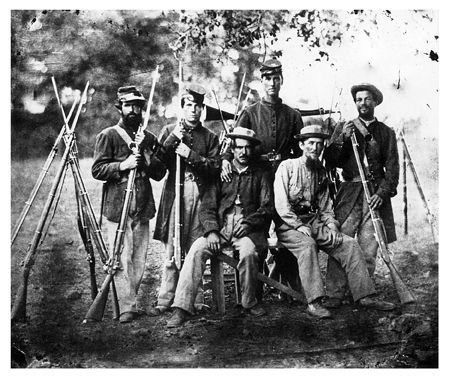A Quest Fulfilled
by Diana Loski

Confederate troops
(Library of Congress)
James Herbert was a farmer from Howard County, Maryland, who traded in his plow for a sword when war erupted in 1861. Throwing his lot in with the 1st Maryland Infantry Regiment, the captain of Company D. Serving the Confederacy, he was present at the Battle of First Manassas.
During the fight, he saw a Union officer fallen and mortally wounded in the fray. The day was hot, the battle chaotic; Herbert reached the dying soldier and pulled him into the shade. He managed to make the man’s final moments more comfortable.
As Captain Herbert placed the unconscious man under a nearby tree, the officer’s wallet fell from his pocket. Another Confederate soldier, who witnessed the scene, stooped to retrieve it, but Herbert intervened. “I’ll take care of that,” he said. As he took the item in hand, he noticed that the Union soldier had expired.
A quick perusal of the contents of the billfold told the captain that the deceased was a Captain Brown, a native of New York. Later that evening, when Herbert had time to examine the contents, he saw that the wallet contained fifty-seven dollars in gold. It was a significant sum.
The young captain knew that the dead man had been his enemy, yet, he was also a man with a family. Herbert decided that, if he survived, he would return the wallet to Captain Brown’s wife and tell her of her husband’s final moments.
Through the next two years, Herbert endured many battles, combined with a significant number of hardships, as part of the Army of Northern Virginia. He served in the Shenandoah with General Thomas J. Jackson. There were endless privations, illness, and multiple battles. Many times the lure of Captain Brown’s gold would have eased the rigors of the struggle, but Herbert held true to his quest.
When Herbert entered Gettysburg on July 1, 1863 with the Maryland troops, now under Brigadier General George “Maryland” Steuart, Herbert served as the regiment’s lieutenant-colonel. Suffering from intense heat exhaustion, the regiment had not drawn rations for two days. Stopping by the Eagle Hotel on Chambersburg Street in town with his comrade William Goldsboro, Herbert consumed two biscuits and drank some water. It was the only sustenance he would receive for the duration of the battle.
On July 2, as darkness fell over the field and hillocks, the Maryland troops scaled Culp’s Hill. The noise of Union soldiers on the heights, along with the darkness, gave the Confederates pause. They were ordered to attack again at first light.
The fight on Culp’s Hill on the morning of July 3, 1863, was the longest sustained fight of the three-day battle, lasting nearly seven hours. Steuart’s Marylanders attacked the heights of the hill and were repulsed, taking heavy casualties. One of the seriously wounded was James Herbert, who was carried to a field hospital and taken prisoner.
As the days passed into weeks, and the more critically wounded needed more centralized care, Camp Letterman was formed. The large hospital, made up of multiple tents, stood east of town on the York Road. Lieutenant-Colonel Herbert was given a cot near the entrance of one of the tents.
While recuperating at Camp Letterman in early August, Herbert overheard a conversation outside his tent. A woman’s voice asked earnestly about her husband, from whom she had not heard in over two years. When she learned that the particular tent she neared was full of Confederate soldiers, she asked, “I wonder if any of them know about my husband.” She had visited the Union tents without success.
She introduced herself as Mrs. Brown from New York.
James Herbert told her that he did indeed have information on her husband. Producing the wallet with the proper identification and the fifty-seven dollars in gold, he gently broke the devastating news to Brown’s widow. She gave the Confederate officer her grateful thanks, relieved to know the truth at last. The money, too, was gratefully received.
Lieutenant-Colonel James Herbert, survived his Gettysburg wound. He endured some time as a prisoner of war at Johnson’s Island on Lake Erie before his parole. At war’s end he was promoted to the rank of Brevet Brigadier General. After the war he returned to civilian life in Howard County, married, and enjoyed raising a family. He became a regular attendee of Confederate reunions in Baltimore. He died in 1884 of typhoid fever. He is buried in Baltimore.
On Culp’s Hill, the monument of the 2nd Maryland CSA (formerly the 1st Maryland Infantry) stands on the slopes, dedicated in 1887, a few years after its lieutenant-colonel passed away. It is the first Confederate monument to grace the Gettysburg battlefield.
Already remembered as a valiant soldier, he deserves accolades for the kindness he showed to a concerned and lonely woman, anxious for news of her husband, long after the guns at Gettysburg were silenced. His two-year quest had at last been fulfilled.
Sources: James Herbert Family Tree, ancestry.com. The Second Maryland Infantry, An Oration Delivered on Friday, May 7, 1909 at Annapolis, Maryland by Lt. Randolph McKim. “An Act of Kindness at Gettysburg”, the Second Maryland Battalion File, Gettysburg National Military Park (hereafter GNMP). The Telegram (A Baltimore Newspaper), August 7, 1889, copy, GNMP. Goldsboro, William. The Maryland Line. Port Washington, NY: Kennikat Press, 1972.

